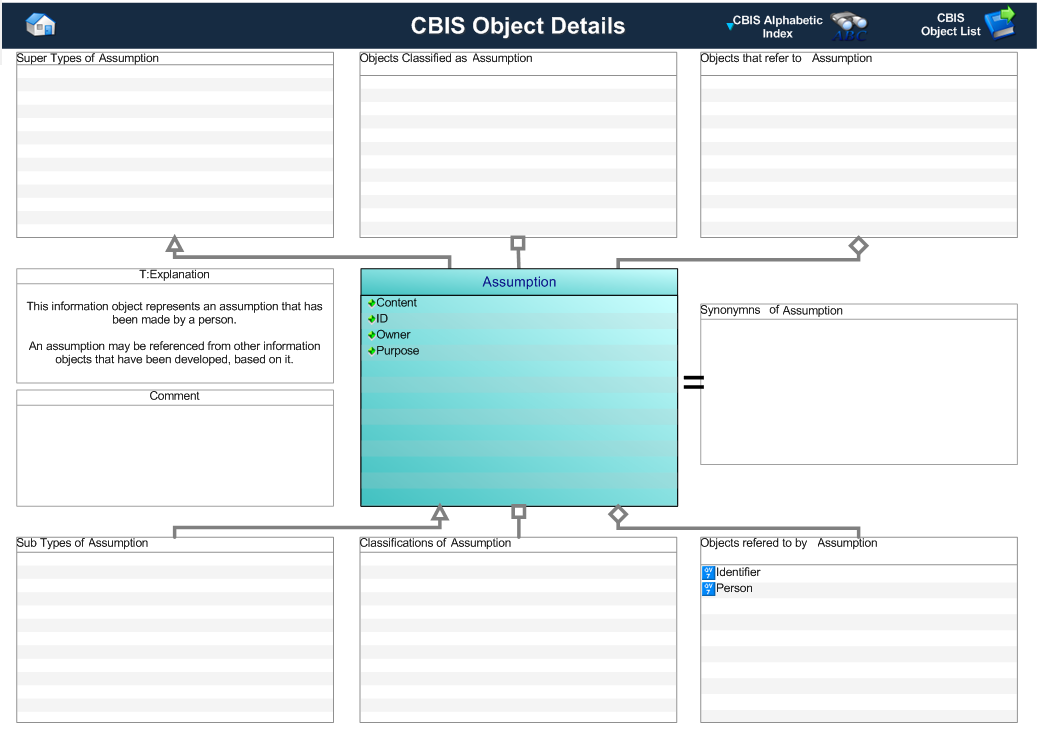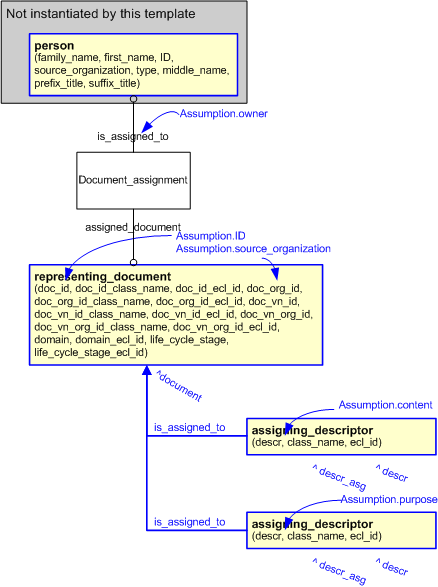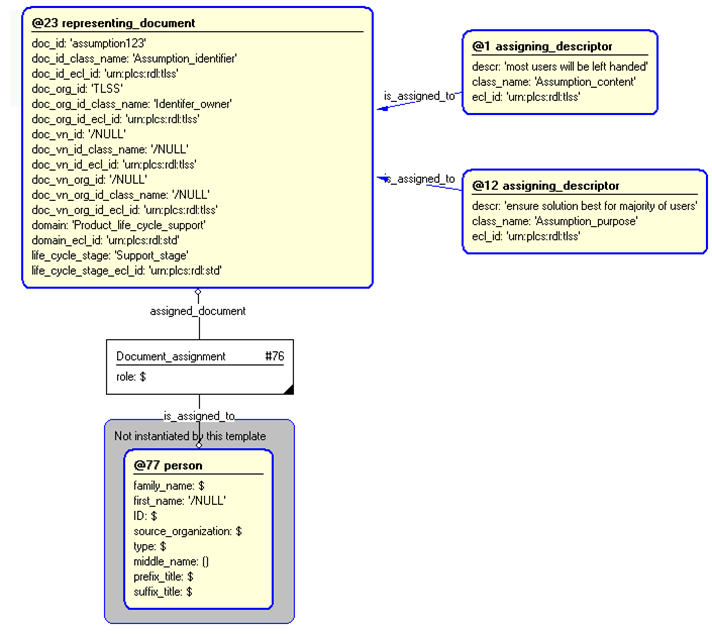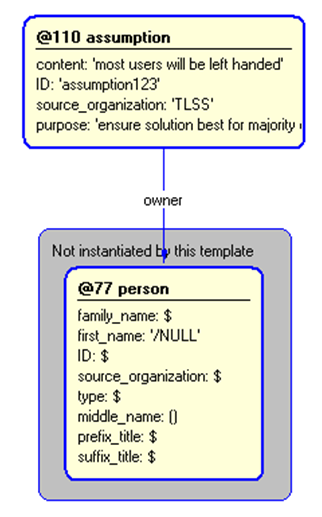Template:— assumption (assum)
Context:— UK_Defence |
Date: 2009/04/17 10:24:34
Revision: 1.4
|
This section specifies the template assumption.
NOTE
The template has been defined in the context of
UK_Defence.
Refer to the business context for details of related templates.
NOTE
An explanation of a template and the associated instantiation path is
provided in the
Template overview
section.
This template describes how to represent an assumption that has been made by a person.
An assumption may be referenced from other information objects that have been developed, based on it.
The assumption business object is used by those UK_Defence Data Exchange
Specifications that require information about a required precondition used as a basis for decision.
Figure 1 — Graphical Representation for Business Object Assumption
Assumption:
The definition of an Assumption object is:
Data about a required precondition used as a basis for decision.
|
Attribute name
|
Attribute description
|
Attribute type
|
Optionality
|
| Content |
This is the text of the assumption. |
Intrinsic |
Mandatory |
| ID |
This is the Identifier of the assumption. |
Identifier |
Mandatory |
| Owner |
This is the reference to the person who made the assumption. |
Relationship to Person |
Mandatory |
| Purpose |
This is the purpose of the assumption. |
Intrinsic |
Mandatory |
Table 1 — Assumption attribute details
The EXPRESS-G diagram in
Figure
2
shows the templates and EXPRESS entities that are required
to represent the template
"assumption".
The text highlighted in blue shows the template parameters.
Figure 2 — An EXPRESS-G representation of the Information model for assumption
The graphic for the template to be used in other EXPRESS-G diagrams
is shown in Figure
3
below.
Figure 3 — The graphical representation of the assumption template
The following input parameters are defined for this template:
This is the text of the assumption
This is the identifier of the Operating_environment.
The organization that created the associated identifier. Additionally
a Person or Information System could be defined when either of these are the source; see Identifier template.
This is the reference to the person who made the assumption.
This is the purpose of the assumption
The following reference parameters are defined for this template:
Allow the
Document
entity instantiated in this path to be referenced when this template is used.
Note: The
Document
entity can be referenced in a template path by:
%^target = $assumption.assumption%
where
target
is the parameter to which the
Document
is bound.
The following parameter combinations specify a uniqueness constraint:
Unique constraint: Assumption
Each instance of the
entity
(
Document)
within the data set shall be uniquely identified
by a combination of the following parameters on this
template (assumption) namely:
ID,
owner.
The
instance is
referenced by the following template parameter:
assumption.
The instantiation path shown below specifies the entities that are to be
instantiated by the template.
A description of templates and the syntax for the instantiation path is
provided in the
Templates Help/Information section.
-- Instantiate a description to indicate the assumption Id /
representing_document(
doc_id=@ID,
doc_id_class_name='Assumption_identifier',
doc_id_ecl_id='urn:plcs:rdl:uk_defence',
doc_org_id=@source_organization,
doc_org_id_class_name='Identifier_owner',
doc_org_id_ecl_id='urn:plcs:rdl:uk_defence',
doc_vn_id='/NULL',
doc_vn_id_class_name='/NULL',
doc_vn_id_ecl_id='urn:plcs:rdl:uk_defence',
doc_vn_org_id='/NULL',
doc_vn_org_id_class_name='/NULL',
doc_vn_org_id_ecl_id='urn:plcs:rdl:uk_defence',
domain='Product_life_cycle_support',
domain_ecl_id='urn:plcs:rdl:std',
life_cycle_stage='Support_stage',
life_cycle_stage_ecl_id='urn:plcs:rdl:std')/
%^assumption = $representing_document.document%
-- Instantiate a description to indicate the assumption content /
assigning_descriptor(
descr=@content,
class_name='Assumption_content',
ecl_id='urn:plcs:rdl:uk_defence',
is_assigned_to=^assumption)/
-- Instantiate a description to indicate the assumption purpose /
assigning_descriptor(
descr=@purpose,
class_name='Assumption_purpose',
ecl_id='urn:plcs:rdl:uk_defence',
is_assigned_to=^assumption)/
-- Instantiate a Document_assignment to indicate the assumption owner Document_assignment-- Set the Document_assignment attribute role to be ignored Document_assignment.role = '/IGNORE'
Document_assignment.assigned_document ->
^assumption
Document_assignment.is_assigned_to ->
@owner
The following entities are instantiated with attributes as specified:
The instance diagram in Figure
4
shows an example of the EXPRESS entities and templates that are instantiated by the template:
/assumption(content='most users will be left handed', ID='assumption123', source_organization='UK_Defence', owner='@77', purpose='ensure solution best for majority of users')/
(an illustration of the consolidated assumption template is shown in
Figure
5 below.)
Figure 4 — Entities instantiated by assumption template
The instance diagram in
Figure
5
shows the graphic symbol for the template that is to be
used in other instance diagrams. The example template is:
/assumption(content='most users will be left handed', ID='assumption123', source_organization='UK_Defence', owner='@77', purpose='ensure solution best for majority of users')/
Figure 5 — Instantiation of assumption template
Characterizations
No common characterizations of the template
assumption
have been identified. However, the ISO 10303-239 EXPRESS model
may enable other assignments to the entities instantiated by the template.




